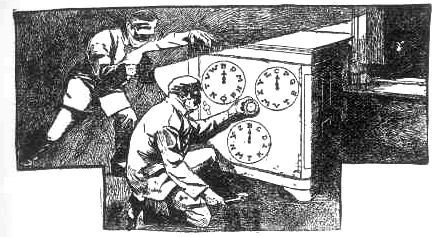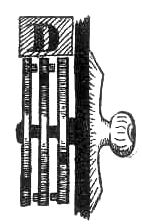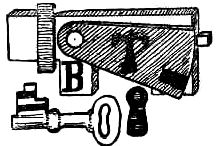



THE principle of a safe lock, of the kind most generally known as a combination lock, pertains to the nature of a puzzle pure and simple, and, indeed, such locks are referred to by the oldest writers on the subject as puzzle-locks. A combination lock is nothing but a puzzle, and its safety depends entirely upon the difficulty, or rather the improbability of a person guessing the right combination.
Here are two literary burglars, bent on opening a safe by guessing the three letter word which serves as the key. You can see that there are but ten letters on each dial, so you can open the safe by finding a three-letter dictionary word, one letter of which is shown on each dial.
As comparatively few persons understand anything about the principle of a safe lock, it will be of general interest to give a simple explanation of the inside workings:
Look at the construction of the first combination lock ever made; and despite of the thousands of patents and great improvements made of late years, the principle is always the same. I have taken out numerous patents on improvements to make them safer, but bankers and others who have large sums of money locked up in their safes would feel more apprehension if they understood the real nature of a combination lock. It might baffle a burglar for a month, but is just as likely to be opened in from one to twenty minutes. On several occasions when I was called in to open a safe lock the trick did not require fifteen minutes.
During the Paris Exhibition of 1867 I was so lucky as to open three French safe locks in less than half an hour, but then at that time the French locks were absolutely worthless.
Let us take an inside view of that lock the burglars are working on.

Each outside dial connects with a round disk or tumbler with a slot which must be placed in position to receive that crooked hook which we call the dog. You cannot turn the middle handle which draws the bolt until all three of the disks are in their proper position at the same time, and you can only tell when they are in their correct position by knowing the proper letters to which the lock is set. If there are only ten letters on each dial and there are but three tumblers, the burglar will probably open the safe in fifteen minutes, for 10 x 10 x 10 gives but 1,000 possible changes, so the chancer are he will hit it in 500 trials.
I give this primitive illustration of a three tumbler lock, because it is the same that A. C. Hobbs, the famous American expert brought to me somewhere about 1851. when he picked the great Brahmah lock in London and won two hundred guineas.

The tumblers are placed upon one pin now, which is a great improvement. The dog (marked D) falls from its weight into the nitches when they are placed in proper position. You can only turn the one handle, placing the tumblers in position one at a time. Turning three times forward, twice backwards and then one forward again.
The tumblers of the ordinary key locks are guarded much in die same way:

In the above illustration the bolt is kept from being drawn back to the right by the tumblers marked T. They turn on the round pin and pres against that little square dog. The key therefor at the same time that it pushes the bolt back must have stop or wards which will raise the tumblers exactly to the correct height to receive that square pin in the slots.
The literary burglars have to guess the word PYX.
2. A Riddle
I with a pen my first display;
My next increases day by day.
My whole is fraught with anxious fears
For those who'd hope for many years.
Cipher Answer.— 4, 15, 20, 1, 7, 5.
DOTAGE
[Page 15]